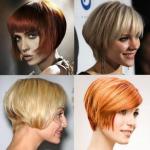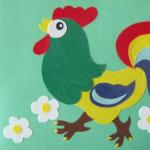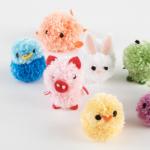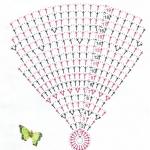How to make a cat from corrugated cardboard. DIY corrugated cardboard dog for children
With just a little fantasy and imagination, you can make a huge variety of crafts from the simplest materials. From the early age kids are happy to take part in creating bright and original applications, and a little later they make three-dimensional figures with genuine interest.
One of the most flexible materials from which many interesting and original products can be made is corrugated cardboard. Working with him takes a long time and brings a lot of positive emotions not only to the kids, but also to their parents. In this article we will tell you how to make crafts from corrugated cardboard for children, and we will offer several ideas for creating original decorations.
How to make crafts from corrugated cardboard with your own hands, step by step?
Creation various products from this material is not an easy task. Despite this, it is very popular among those who like to do things with their own hands. Most often, boys and girls create crafts in the form of animals and favorite fairy tale and cartoon characters from strips of corrugated cardboard.
Using the following detailed instructions, you and your child can easily make a cute Cheburashka:
- Prepare 4 yellow and 1 brown strips of corrugated cardboard to create the face of our Cheburashka. Twist them, squeeze them out and glue them inside with hot glue. In exactly the same way, prepare the future back of the head using 5 brown stripes.
- Make 2 body elements in the same way. The front will consist of 3 yellow stripes and 1 brown, and the back will consist of 4 brown stripes.
- Connect the two parts of the head together, as shown in the figure, and glue them together using a strip of paper.
- Connect the 2 body elements in the same way.
- For one leg you will need 2.7 strips of brown corrugated cardboard. Twist them, squeeze them out lightly and glue them. Repeat again to create the second leg.
- The glued paws should look like this. The glue should be at the bottom.
- You only need one strip for each handle. Count out 8 corrugated ribs, fold and shape the required form, resembling a drop.
- For one ear you should take 3 yellow and 2 brown stripes. Twist them in the same way as to create other elements, then squeeze them out lightly and glue them on the convex side - this will be the back of the ear. At the future junction with the head, press down the parts a little with your fingers.
- Carefully connect the elements to each other. The largest ball - the head - should be located on top. Glue it to the body, and then attach two legs from below.
- Glue to practically finished toy ears, detail the facial features the way you like, and add any decoration elements, such as a bow. A magnificent animal named Cheburashka is ready!










So as not to waste time on selection necessary materials, very often they purchase ready-made kits for creating crafts from corrugated cardboard using the quilling technique. In them you will find several strips that you will need during the work process, suitable glue, as well as decoration elements. In addition, such sets almost always include detailed instructions, with which to make bright and original toy Even a small child can do it without much difficulty.
Similar crafts made from corrugated cardboard can become a great gift on New Year, especially if you have a symbol of the coming year. In addition, using this material and the technique popular today, you can make incredibly beautiful Christmas decorations, garlands, as well as New Year's figurines of snowmen, Father Frost and Snow Maiden.
 |
 |
 |
 |
 |
 |
 |
 |
 |
PS).
search
Tips for photographing crafts) or filmed (see how to upload a video).
Attention: Terms of use
The crafts look very impressive.
Recently, my daughter and I discovered a completely new use for corrugated cardboard - three-dimensional crafts.
Volumetric crafts made from corrugated cardboard are easy to make. They can become a child's toy or interior decoration. But we found another use for them - .
You will need:
- sheets of corrugated cardboard of different colors;
- scissors;
- ruler;
- PVA glue;
- shifty eyes;
- thin ribbon or beautiful thread.
Preparing for the craft
We cut the sheets of corrugated cardboard into strips 1 cm wide. For some small parts, narrow strips of 0.5 cm will be needed. From these strips we will roll circles - the basis for crafts.
Looking ahead, I will say that for the manufacture of large parts (head, torso) you will need a strip 1-2 meters long. Standard sheets of corrugated cardboard are about 28 cm long. Therefore, cut the required number of strips (3-4 strips for example) and during the rolling process simply glue them next to each other.
The scheme of all crafts is the same. The only difference is in the scenery. Let's look at making the main parts using the example of a tiger cub.
1. For the head you will need a strip 1 cm wide and 1 meter long.
We cut strips along the length of the sheet, measure and determine how many strips we need up to a meter (usually 3-4 strips). Then we take the first strip and twist it into a tight circle. We glue the end, and next to the joint we glue another strip.

For the muzzle you will need a strip 0.5 cm wide and 50 cm long.
For ears: width 1 cm, length 16 cm.
For the spout: width 0.5 cm, length 7 cm.
2. For the torso:
- one orange stripe 1 cm wide, 50 cm long.
- one white stripe 1 cm wide, 50 cm long.
3. For the paws: 4 strips 1 cm wide and 16 cm long.
The process of creating a tiger cub from corrugated cardboard
We twist a circle for the head, a circle for the muzzle, a nose, and two ears, gluing the ends of the corrugated cardboard. Using the circles for the ears, we form triangles with our fingers.
When twisting, we try to make the first turns tightly.
My daughter and I did this: I started rolling it tightly and passed it to Anya. When the tape ran out, Anya re-glued it and rolled it further. Then I held the circle until the glue set, at which time I began to twist the second part.
When all the parts are ready, we glue them together, forming the face of the tiger cub and decorate it as we wish. Our tiger turned out to be angry - this is Anya’s idea - a saber-toothed tiger from “The Wizard of the Emerald City”.

By analogy, we form the torso.
To add volume to a corrugated cardboard craft, you need to squeeze out the middle of the circle with your finger, forming a dome. For strength, coat the inside with PVA glue. In a tiger cub, volume can be created on the tummy.
Christmas tree toys made of corrugated cardboard
To make a Christmas tree decoration, when twisting the head in the last circle, insert thin tape and fix it with glue. We didn't do this because the idea with Christmas tree toys came later.
But no problem. In the intervals, we will insert a regular thread using a needle and hang the tiger cub on the Christmas tree. And we’ll make the next toy – a three-dimensional snowman – as it should be.

photo from the Internet
I found a lot of ideas for crafts made from corrugated cardboard in the book
Due to its flexibility and at the same time strength, corrugated cardboard is a very convenient material for crafts. Corrugated cardboard holds its shape perfectly, for which it is valued by paper rolling masters. Today we will talk about the technique of making crafts from corrugated cardboard.
Elena Zhukova makes crafts from corrugated cardboard herself and teaches it to children. Just think - the colored stripes can be twisted in such a way that you can get any character from a fairy tale, or an animal, or a wonderful flower. Admire it for yourself.






Crafts made from corrugated cardboard: aristocratic dog
Elena will tell us how to make such an aristocratic dog out of corrugated cardboard:

To make it we need :
Corrugated cardboard:
Orange stripes 43 pcs. + 1 strip for gluing joints
Yellow stripes - 4 pcs.
Plum stripes (the hat will be made from them) - 7 pcs.
To make it we will need:
heat gun
eyes
ribbon
good mood
Let's get started?
Torso
You need to glue two long strips, each of 6 (7) strips.
1. Count 18 ribs, bend at the 19th and twist two ovals

2. These are the resulting blanks for the body. This time the strips turned out to be soft, so they don’t fit tightly in the middle, but that’s okay, it will all stick together later.

3. Now we give the desired shape to our blanks. The first one, for the back, we pull out and push out as high as possible, but at the same time we make the back (top) itself flat, we need to glue the neck to it.

4. We push out the second one, the abdomen, just a little bit, literally 3-4 rows of stripes. The bottom part should be as wide as possible - to glue the paws.

5. Coat both blanks with hot glue. I coat the bottom or the bottom of the resulting boats completely, thickly, squeezing them together so that they do not diverge and there are no cracks. And then up the sides - rays - strips of glue.

6. Apply glue to the very edge of one of the blanks and connect the back to the abdomen

7. Seal the joint (connection point) with a strip

The body is ready

Head
1. Glue two long strips of 3 strips each. Roll two round tablets.

2. Give it shape. We form the back of the head into a hemisphere.

3. For the muzzle, we extend the cone, bend this cone, and form a slightly upturned muzzle

4. Coat the inside with glue. I pour more glue into the nose on the face

5. Apply glue to the edge of one of the blanks...

6. Glue the back of the head and the muzzle, glue the joint with a strip


Neck
We prepare two strips of two strips each. We twist two identical tablets and glue them together. Set the resulting neck aside.

Ears
Glue two strips of 2 yellow and 2 orange strips, count 18, fold and twist two ovals

Squeeze a little on one side and squeeze out a little in the wide part (shape the ears), coat the inside with glue

Paws
1. Roll 8 identical tablets, each from one strip. We glue two tablets together. Total - we get 4 legs
2. Roll up 4 tablets, each of the two strips is the pads of the paws. (at this stage I realized that I didn’t have enough orange stripes, so I glued the pads together from yellow and orange folded together). Squeeze the pads of the paws a little - make them a little oval

3. Glue the paws to the pads

In the photo above we see that you need to lubricate the inner sides of the paws to the middle (mine is a little less, I tried it on - that’s exactly what happens). Now we glue the body. Glue the neck in place

and glue the head

Glue the ears in place

hat
1. To make a crown, you need to twist a tablet of three strips, squeeze it out with a deep sphere, coat it inside

2. For the brim of the hat, take 4 strips, cut them widthwise, from the resulting 8 narrow strips we glue one strip and twist the disk. We push out the middle of this disk a little. We coat the recess with hot glue, and PVA - the brim of the cap. Let the PVA glue dry (let's go have some tea, that's just enough time :)
Quilling from corrugated cardboard. Master class with step-by-step photos
Master class: craft from corrugated cardboard “A heartfelt gift for dad and mom”
Author: Fateeva Oksana Yuryevna, methodologist in arts and crafts and fine arts MBOU DOD TsRDiYu, Kamensk-Shakhtinsky, Rostov region.The master class is designed for work in a children's creative association for children 7-10 years old and older, for teachers, and parents.
Purpose: This work is a gift made with your own hands.
Purpose of the master class: master the technique of quilling from corrugated cardboard.

Progress:
The cat consists of a heart-shaped body, stand legs, muzzle, ears and tail.
At the first stage It is necessary to cut 10 strips 1 cm wide from red cardboard in length. These are blanks for the heart-shaped body.

The heart consists of two parts - dense disks oval shape. For each disk it is necessary to glue tapes of 5 strips with PVA glue.

And then, stepping back from the edge, twist 10 tubercles into tight oval disks.

We press the disks, giving the shape of a drop. Glue the heart together.
Second phase: We prepare the paws-stands, muzzle, ears and tail. From cardboard white cut 12 strips 5 mm wide in length.

We divide the first strip into two equal parts and twist a tight disk from each half.

We squeeze and shape into triangles - these are the ears.

One whole strip is a tight disc. This is a cheek. The cat has two of them.

Give the cheeks a teardrop shape

The foot-stand requires 6 strips. The base is two tight disks made of two strips. We give them a droplet shape and glue them together like a heart. For “fingers”, divide the strip into 4 equal parts. We twist each part into a tight disk.

We divide one strip in half. From the half we twist a disk - a beard for the muzzle. We cut the remaining half in half again and twist two more “fingers”.

The tail is made from the remaining strips. Having glued them into a tape, and stepping back 15-20 tubercles from the edge, we twist an oval-shaped disk, similar to the halves of a heart. The tail will turn out to be “loose”; to strengthen it and give it the desired shape, glue on red stripes.






